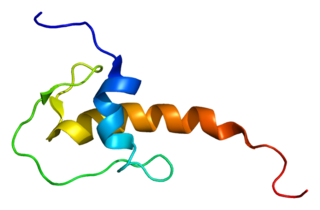Fermitin family homolog 1 is a protein that in humans is encoded by the FERMT1 gene. [5] [6] [7]
Fermitin family homolog 1 is a protein that in humans is encoded by the FERMT1 gene. [5] [6] [7]

Keratin, type I cytoskeletal 4 also known as cytokeratin-4 (CK-4) or keratin-4 (K4) is a protein that in humans is encoded by the KRT4 gene.

Keratin 2A also known as keratin 2E or keratin 2 is a protein that in humans is encoded by the KRT2A gene.

Keratin, type I cytoskeletal 17 is a protein that in humans is encoded by the KRT17 gene.

Keratin 16 is a protein that in humans is encoded by the KRT16 gene.

Treacle protein is a protein that in humans is encoded by the TCOF1 gene.

ATP-binding cassette sub-family A member 12 also known as ATP-binding cassette transporter 12 is a protein that in humans is encoded by the ABCA12 gene.

Kindler syndrome is a rare congenital disease of the skin caused by a mutation in the KIND1 gene.

LIM homeobox transcription factor 1-beta, also known as LMX1B, is a protein which in humans is encoded by the LMX1B gene.

Gap junction beta-3 protein (GJB3), also known as connexin 31 (Cx31) — is a protein that in humans is encoded by the GJB3 gene.

Lympho-epithelial Kazal-type-related inhibitor (LEKTI) also known as serine protease inhibitor Kazal-type 5 (SPINK5) is a protein that in humans is encoded by the SPINK5 gene.

Loricrin is a protein that in humans is encoded by the LOR gene.

Sterol-4-alpha-carboxylate 3-dehydrogenase, decarboxylating is an enzyme that in humans is encoded by the NSDHL gene. This enzyme is localized in the endoplasmic reticulum and is involved in cholesterol biosynthesis.

DNA excision repair protein ERCC-8 is a protein that in humans is encoded by the ERCC8 gene.

Hermansky–Pudlak syndrome 1 protein is a protein that in humans is encoded by the HPS1 gene.

Extracellular matrix protein 1 is a protein that in humans is encoded by the ECM1 gene.

Keratin, type II cuticular Hb6 is a protein that in humans is encoded by the KRT86 gene.

Transmembrane channel-like protein 6 is a protein that in humans is encoded by the TMC6 gene. In vivo, TMC6 and its homolog TMC8, interact and form a complex with the zinc transporter 1 (SLC30A1) and localize mostly to the endoplasmic reticulum, but also to the nuclear membrane and Golgi apparatus.

Gap junction beta-4 protein (GJB4), also known as connexin 30.3 (Cx30.3) — is a protein that in humans is encoded by the GJB4 gene.

Membrane frizzled-related protein is a protein that in humans is encoded by the MFRP gene.

Fermitin family homolog 3) (FERMT3), also known as kindlin-3 (KIND3), MIG2-like protein (MIG2B), or unc-112-related protein 2 (URP2) is a protein that in humans is encoded by the FERMT3 gene. The kindlin family of proteins, member of the B4.1 superfamily, comprises three conserved protein homologues, kindlin 1, 2, and 3. They each contain a bipartite FERM domain comprising four subdomains F0, F1, F2, and F3 that show homology with the FERM head (H) domain of the cytoskeletal Talin protein. Kindlins have been linked to Kindler syndrome, leukocyte adhesion deficiency, cancer and other acquired human diseases. They are essential in the organisation of focal adhesions that mediate cell-extracellular matrix junctions and are involved in other cellular compartments that control cell-cell contacts and nucleus functioning. Therefore, they are responsible for cell to cell crosstalk via cell-cell contacts and integrin mediated cell adhesion through focal adhesion proteins and as specialised adhesion structures of hematopoietic cells they are also present in podosome's F actin surrounding ring structure. Isoform 2 may act as a repressor of NF-kappa-B and apoptosis